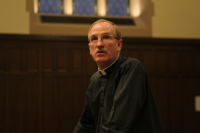A new planning initiative created by the university president is asking the student body for feedback on what should Fordham strive to look like in the coming years. The university president met with 22 faculty members on Sept. 9 in the first meeting of the Continuous University Strategic Planning committee (CUSP).
CUSP, composed of faculty, administrators, deans and students, was created by Rev. Joseph M. McShane, S.J., president of the university, in April of this year. It meets monthly to assess the needs of the university for the next 10 years in what is called by CUSP a “continuous planning process.”
“It is time for the university to think very careful about how to deeply the tremendous resources that we have that is in keeping with our mission as a Jesuit school,” said Patrick Hornbeck, associated professor of theology, Faculty Senate secretary and co-chair of CUSP.
McShane appointed Hornbeck, Debra McPhee, dean of the Graduate School of Social Service and Peter Stace, vice president for enrollment as co-chairs of CUSP.
Hornbeck offered insight on how CUSP can increase the efficiency of a university that employs hundreds of faculty members and caters to over 15,000 students.
“In many cases the different processes that govern administration of the university do not always line up with each other….We hope that CUSP can allow us to make recommendations as to how the university can work in a more holistic and more efficient way.”
According to Hornbeck, CUSP will meet monthly and reach out to student organizations in the meantime to get feedback on what they believe could be incorporated into its goals.
“First semester will be an information gathering semester,” explained Hornbeck.
“At our next monthly meeting on Oct. 13, CUSP plans to draw up a list of all organizations. Right now that includes USG of both campuses, as well as student associations for graduate and professional school.”
On CUSP’s website, McShane lists the two objectives of the planning initiative.
“First, we will build on the strengths of the university and its schools and use this foundation to create a fresh vision for Fordham’s future in the form of a strategic framework that will guide us in the coming years. Second, we will design a process of continuous planning — one that ensures that we are continuously monitoring our internal and external environment and modifying our plans to take advantage of new challenges and opportunities that arise.”
To assist CUSP, Fordham will continue to use AKA Strategy (AKA), a consulting firm that helps institutions of higher education with strategic planning. McShane notes that AKA Strategy has worked with the university in the past.
“The AKA consultants will serve as facilitators of the process and will also conduct interviews and analyses and prepare drafts of the strategic framework and models of the continuous planning process for CUSP to discuss and develop,” McShane said in an email.
CUSP is not the first planning initiative that McShane has established since taking office. In October 2003 he created a strategic plan entitled Toward 2016, which incorporated a myriad of university initiatives put in place to achieve ultimate goals in 2016. The plan’s mission was for Fordham “to regain national prominence and preeminence among Catholic institutions.”
Towards 2016 outlined very detailed goals for the 10 years for which it was designed.
Some of these goals were achieved, such as having at least 30 percent minority and international students. However, several others, such as reducing the university’s acceptance rate and maintaining benchmarks for SAT 1350-1400 range and students that perform in the top quartile of their high school class were not reached. Notably, the goal of having targeted endowment of $2 billion by 2016 mapped out in the Towards 2016 plan are likely to blame for these growing pains. The current university endowment is $700 million, approximately 35 percent of the 2016 goal that was set a decade ago.
Hornbeck attributes the endowment shortfall to the the economic climate in 2008 and the loss of a significant amount of the university’s endowment in the stock market.“Like everybody else we had part of our endowment invested in the stock market…when the market went down the value of our investments went down.”
Hornbeck noted that CUSP’s goals are to be broader and less specific.
“We don’t want to be binding ourselves into a set of goals articulated in a set of goals ten or more years in advance then we wouldn’t have an opportunity to be flexible,” Hornbeck explained.
“So the goals will be broader and less specific. Every year or so [we will] look back at initiatives and ask if those are still good and getting us where we want to go, and whether or not we need to make slight adjustments,” he said.
Hornbeck said that through a method of constant adjustment, as opposed to setting goals 10 years in advance, CUSP might better meet the needs of the university.
“Our hope is that the goals we have articulated in this first phase will stand the test of time for at least a number of years…we do anticipate this being a process of continuous planning,” Hornbeck said.





